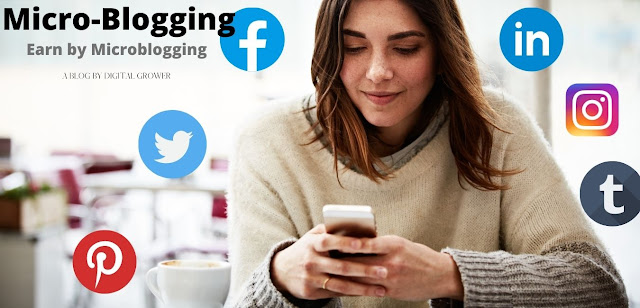In January of 2019, Contently, a content marketing platform that connects enterprise brands with freelance talent, surveyed over 1,000 people within the U.S. about their media and marketing preferences. What they uncovered about people’s preferred content length shattered a seemingly unbreakable convention that longer is usually better: 75% of individuals like better to read articles under 1,000 words.
With our ever-dwindling ability to consider given tasks, Contently’s discovery makes complete sense. Writing shorter articles is best because people prefer consuming that sort of content.
However, longer articles typically rank higher on Google and generate more website visits because these sorts of resources are more comprehensive and better equipped to unravel the searcher's intent.
So how does one reconcile these two ideas, and when is it appropriate to craft concise content? Fortunately, the solution lies in microblogging.
What is microblogging ?
Microblogging refers to the act of making concise posts for brief audience interactions, often on common microblogging platforms like Twitter and Tumblr. additionally, to text, a post on a microblog can include links, audio, images, and even video.
This form is best used when:
The subject or post has low search intent but a high potential for virality.
You would like to require advantage of the communities on common microblogging platforms.
You're covering a live event or providing timely updates.
You're using your microblog as a vehicle for delivering multimedia content without tons of accompanying text.
The conundrum then becomes how you'll create a microblog without filling your site with thin content, which may hurt your site when it involves search because Google sees these pages as low-value.
While it isn't necessary (as evidenced by the FiveThirtyEight example below), most microblogging happens on platforms designed specifically for the aim.
Microblogging Sites
Twitter
Tumblr
Pinterest
Instagram
Facebook
LinkedIn
1. Twitter
The OG of microblogging sites, Twitter isn't just one of the foremost popular microblogging sites around, but it’s also one among the foremost popular social media platforms around.
On Twitter, you'll create a profile where all of your posts -- or Tweets -- live. In your Tweets, you'll include text, links, photos, videos, GIFs, audio, and more. Each of your Tweets also features a 280-character cap. Additionally, you'll reply to and share -- or retweet -- other users’ Tweets.
2. Tumblr
With over 497 million different blogs, Tumblr is a bustling hub of short-form content. On the microblogging site, you can create a blog and include links, text, photos, GIFs, videos, Spotify tracks, MP3 files, and more in your posts. once you follow other blogs, their posts will show up on your dashboard. you'll also discuss and reblog other blogs’ posts on your blog.
3. Pinterest
Unlike most microblogs, Pinterest is only visual. On your profile, you'll create Boards, which are collections of images curated around a selected topic, post Pins of your favorite pictures, and add Tries, which are notes and photos of ideas you posted, like new recipes you cooked or new places you traveled to. you'll also follow other people’s profiles and topics, which are the foremost popular Boards that cover specific topics.
4. Instagram
While Instagram is usually a visible platform -- like Pinterest -- Instagram also allows you to add 2,200 character long captions to every photo or video you post on your profile. Some media outlets are even leveraging Instagram to spark a replacement phase of journalism that focuses on crafting visually appealing articles.
On Instagram, you'll follow other profiles and popular hashtags, discover new content based on your user behavior and popular topics, watch long-form videos and Instagram stories, discuss posts, tag your friends in posts, and direct message them.
5. Facebook
You might know Facebook because the hottest social media network in the world. But it is also the foremost robust microblogging platform out there.
On Facebook, you'll create a profile where you'll share text-based updates, photos, GIFs, videos, an emotion you’re feeling, an activity you’re currently doing, and therefore the location you’re currently in.
You can also invite recommendations on where to travel when you’re close to visit a location, tag friends and events in your updates, poll your friends, support and donate to a nonprofit, answer an issue about yourself, create fun lists, post-Facebook Stories, record live videos, interact together with your friend’s updates, message, call, and video chat with them, start groups with them, create events, watch videos, sell and buy products, and play games.
6.LinkedIn
LinkedIn is an online media stage outfitted towards business experts, however, it in any case has an incredible microblogging arm. Not exclusively would you be able to utilize LinkedIn's distributing usefulness to post articles, yet you can likewise utilize notices for short-structure microblogs. With these notices, you can share a photograph, video, occasion, or connection... or on the other hand, you can decide to distribute something longer structure. All that you share or draw in with would then be able to be found on your profile under "Action."
As you likely effectively saw, the vast majority of the microblogging destinations above are likewise the most famous online media locales - however, this shouldn't be amazing. Individuals love looking through online media because they can devour tubs of snackable substance in a short measure of time. What's more, advertisers should take this understanding and apply it to their substance system. Since, very much like eating a sack of Doritos, you never stop after the primary chip.




0 Comments